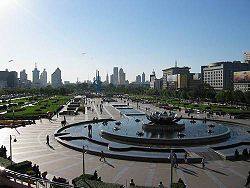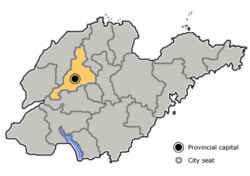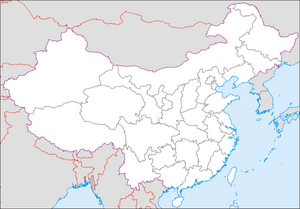Jinan
| Jinan 济南 Jǐnán Shì |
|
| — Sub-provincial city — | |
 |
|
| Nickname(s): City of Springs | |
 |
|
 Jinan
|
|
| Coordinates: | |
| Country | China |
|---|---|
| Province | Shandong |
| County-level divisions | 10 |
| Township divisions | 146 |
| Area | |
| - Total | 8,177 km² (3,157.2 sq mi) |
| Population (2004) | |
| - Total | 5,900,000 |
| - Density | 721.5/km² (1,868.8/sq mi) |
| Time zone | China Standard Time (UTC+8) |
| Postal code | 250000 |
| Area code(s) | 531 |
| License plate prefixes | 鲁A |
| GDP (2007) | CNY 255.4 billion |
| - per capita | CNY 42,171 |
|
|
|
| Website: www.jinan.gov.cn (Chinese) | |
Jinan (simplified Chinese: 济南; traditional Chinese: 濟南; pinyin: Jǐnán; Wade-Giles: Tsinan; in some texts the pinyin without tones is given as Ji'nan, to prevent a possible misreading as Jin'an) is a sub-provincial city and the capital of Shandong province, People's Republic of China. The area of present-day Jinan has played an important role in the history of the region from the earliest beginnings of civilization and has evolved into an important administrative, economic, and transportation hub. The city is located in north-western Shandong, it borders Liaocheng to the southwest, Dezhou to the northwest, Binzhou to the northeast, Zibo to the east, Laiwu to the southeast and Tai'an to the south.
Contents |
Names
The modern-day name "Jinan" literally means "south of the Ji (Waters)" and refers to the old Ji River that once flowed to the north of the city. The Ji River disappeared in 1852, when the Yellow River changed its course northwards and took over the bed of the Ji River. During the times of the Zhou Dynasty (1122 BC to 256 BC), the city of Lixia (Chinese: 历下; pinyin: Lìxià) was the major settlement in the area. The Battle of An, which was fought in the area during the Spring and Autumn Period (in 589 BC) uses the ancient city name An (Chinese: 鞍; pinyin: ān). Marco Polo describes the city under the name "Chingli"[1]. Jinan is also called "City of Springs" (Chinese: 泉城; pinyin: Quán Chéng), because of the many artesian springs.
Administration
The sub-provincial city of Jinan administers 10 county-level divisions, including 6 districts, 1 county-level city and 3 counties.
- Licheng District (Chinese: 历城区; pinyin: Lìchéng Qū)
- Lixia District (Chinese: 历下区; pinyin: Lìxià Qū)
- Shizhong District (Chinese: 市中区; pinyin: Shìzhōng Qū)
- Huaiying District (Chinese: 槐荫区; pinyin: Huáiyìn Qū)
- Tianqiao District (Chinese: 天桥区; pinyin: Tiānqiáo Qū)
- Changqing District (Chinese: 长清区; pinyin: Chángqīng Qū)
- Zhangqiu City (Chinese: 章丘市; pinyin: Zhāngqiū Shì, a county-level city)
- Pingyin County (Chinese: 平阴县; pinyin: Píngyīn Xiàn)
- Jiyang County (Chinese: 济阳县; pinyin: Jǐyáng Xiàn)
- Shanghe County (Chinese: 商河县; pinyin: Shānghé Xiàn)
These are further divided into 146 township-level divisions, including 65 towns, 27 townships and 54 subdistricts.
Geography and climate
Jinan is located in the north-western part of Shandong province at 36° 40′ northern latitude and 116° 57′ east of Greenwich. In the relief of the region, the city occupies a transition zone between the northern foothills of the Taishan Massif to the south of the city and the valley of the Yellow River to the north. Karst aquifers in limestone formations sloping down from the south to the north give rise to many artesian springs in the city area. Because Jinan's geographical location falls within the warm temperate continental monsoon climate zone, Jinan has four distinct seasons. The city is dry and rainless in spring, hot and rainy in summer, crisp in autumn and dry and cold in winter. The average annual temperature is 14.2°C, and the annual rainfall is around 675 mm. January is the coldest and driest month, the monthly averages are -5.4°C for the daily minimum temperature, 3.6°C for the daily maximum temperature, and 6.6 mm for the rainfall. July is the warmest and wettest month, the corresponding numbers are 23.5°C, 32.6°C, and 190.9 mm (Source: The Global Historical Climatology Network, version 2 beta, covering 874 months between 1916 and 1990). Temperature Inversions are common occurrences (about 200 days per year)[2].
History



The area of present-day Jinan has been inhabited for more than 4000 years. The Neolithic Longshan Culture was first discovered at the Chengziya (城子崖) site to the east of Jinan (Zhangqiu City) in 1928. One of the unique features of the Longshan Culture is the skill of pottery making, demonstrated in recovered black pottery relics - some of which are as thin as egg shells.
During the Spring and Autumn Period (722 B.C. - 481 B.C.) and Warring States Period (475 B.C - 221 B.C.), the area of Jinan was split between two states - the state of Lu in the west and the state of Qi in the east. In 685 B.C., the state of Qi started to build the Great Wall of Qi (Chinese: 齐长城; pinyin: Qí Chángchéng) across Changqing county. Portions of the wall still remains today and are accessible as open air museums. Bian Que (扁鹊), according to the legend the earliest Chinese physician and active around 500 B.C., is said to have been a native of present-day Changqing County. Zou Yan (邹衍, 305 B.C - 240 B.C) developed the concepts of Yin-Yang and the Five Elements (阴阳五行说).
In the time of the Han Dynasty (206 B.C. - 220 A.D.), Jinan was the capital of Kingdom of Jibei (济北国) and started to become the cultural and economic hub of the region. In 1995 and 1996, archaeologists from Shandong University excavated the Han Dynasty tombe at the Shuangru Mountain (双乳山汉墓) where the last king of Jibei, Liu Kuan (刘宽) was buried. More than 2000 relics such as jade swords, jade masks, jade pillows have been recovered within the 1,500 square meter excavation site, emphasizing the wealth of the city during the period. Cao cao (曹操, 155 A.D - 220 A.D) was an official in Jinan before he became the de facto ruler of the Han Dynasty. His son overthrew the last emperor of the Han and founded the Wei Kingdom (220 A.D - 265 A.D) of the Three Kingdoms Period.
Since the 5th century, Buddhism has flourished in Jinan. The Langgong Temple (朗公寺) in the southern county of Licheng was one of the most important temples in northern China at that time. The same period witnessed extensive construction of Buddhist sites in the southern counties of Licheng and Changqing such as the Lingyan Temple (灵岩寺) and Thousand-Buddha Cliff (千佛崖). In particular, a large number cave temples were established in the hills south of Jinan[1].
Jinan remained the cultural center of the region during the Song Dynasty (960 A.D - 1279 A.D). The Song rulers promoted Jinan to a superior prefecture in 1116. Two of most important poets of the Southern Song were both born in Jinan: Xin Qiji (辛弃疾, 1140 A.D - 1207 A.D ), the famous patriotic poet who led the peasant rebellion against the Jurchen invasion in 1161 A.D. and Li Qingzhao (李清照, 1084 A.D - 1151 A.D), the most famous female poet in Chinese history. Both of the poets lived in the period when the Song Dynasty suffered major military setbacks against the Jurchens losing almost half of its territories. Although well-known for their patriotism, the poets failed to persuade the government of the Song Dynasty to stand up to the Jin Dynasty established by the Jurchens and recover the lost territories including Jinan. After retreating to southern China and realizing the incapabilities of their government, the poets started to write extensively and passionately about their hope of a stronger nation and recovery of lost lands.
During the Jin (1115 – 1234 AD) and Yuan (1271 – 1368AD) Dynasties, culture in Jinan continued to thrive. One of the most famous artists of the Yuan Dynasty, Zhao Mengfu (赵孟頫, 1254 -1322 A.D) was appointed as the governor of Jinan in 1293 A.D and spent three years in the city. Among the extraordinary art works he completed during his stay in Jinan, the best known painting is "Autumn Colors on the Qiao and Hua Mountains" (鹊华秋色). Geographer Yu Qin (于钦, 1284 A.D - 1333 A.D) was also an official of Jinan and authored his famous geography book Qi Cheng (齐乘) in Jinan.
Jinan became the capital when Shandong Province was established in the Ming Dynasty[1].
The shift of the Yellow River into a new bed to the north in 1852 triggered the modern expansion of Jinan. The new course of the Yellow River connected the city to the Grand Canal and regional waterways in northern Shandong and southern Hebei[1].
German influence in Jinan grew after the Qing Dynasty ceded Qingdao to the German Empire in 1897. The Jiaoji (Qingdao-Jinan) railway was built by the Germans against local resistance. Discontent over the construction of the railway was one of the sources fueling the Boxer Rebellion (1899-1901)[3]. During the rebellion, foreign priests were evacuated from Jinan and Chinese christians became a target of violence. The Jiao-Ji railway was completed after the Boxer Rebellion had been put down, in 1904 and opened the city to foreign trade[1]. The importance of Jinan as a transportation hub was cemented with the completion of the north-south Jinpu railway from Tianjin to Pukou in 1912[1]. Jinan became a major trading center for agricultural goods in northern China. Traded commodities included cotton, grain, peanuts, and tobacco[1]. Jinan also developed into a major industrial center, taking the second place after Qingdao.
In 1919, after the First World War, the Japanese took over the German sphere of influence in Shandong, established a significant Japanese colony in Jinan[1] and took control of the Jiaoji railway.
During the Warlord era of the Republic of China, Zhang Zongchang, nick-named the "Dogmeat General", ruled Shandong from Jinan during the period lasting from April 1925 until May 1928. Zhang was unpopular for his heavy-handed rule and in particular his heavy taxation[4]. He even planned to build a living shrine and a large bronze statue for himself on the shore of Daming Lake, but these plans were not realized.
In spring 1928, the Northern Expedition reached Jinan. On May 3rd, 1928, clashes developed between Japanese troops stationed in Jinan and the Kuomintang troops moving into the city (Jinan Incident). During the Nanking decade of the Republic of China, Han Fuju, a military commander who had aligned himself with the Kuomintang, became military governor of Shandong. He established his base in Jinan and is credited with curtailing banditry and drug trading, but from 1935 onwards came under heavy pressure from the Japanese consul in Jinan to declare Shandong an "independent state" allied with Japan.
After the start of the Second Sino-Japanese War, the Japanese invasion force crossed the Yellow River 60 kilometers north-east of Jinan Shandong on December 23rd, 1937[5]. Han Fuju abandoned Jinan on the next day against orders to hold the city to the death[5]. He ordered the offices of the provincial government and the Japanese consulate to be burned down[5] and the ensuing power vacuum led to wide-spread looting in the city[5]. Japanese Troops entered Jinan on December 27th, 1937[5].
The People's Liberation Army breached the city wall and entered Jinan on September 24, 1948.
Economy
Jinan has a pool of high-quality labor resources. There are 18 universities and colleges in the city where more than 200,000 students are studying. Among the 200+ research institutes in the city, 10 are national laboratories.
The focus on technology intensive industries has transformed Jinan from a city supported by heavy industry and textiles to a city of more complex industrial structures. IT, transportation tools, home appliances, bio-engineered products, etc. have become the new pillars of industry. Jinan's IT-related economic output ranks No.4 in China in 2004.
Industrial zones include:
- Jinan High-tech Industrial Zone
- Liaocheng Economic Development Zone
Transportation

Railways
Jinan is positioned at the intersection of two major railways: the Jinghu Railway running in the north-south direction from Beijing to Shanghai and the Jiaoji Railway that connects Jinan to the sea port of Qingdao in the west. Other major cities connected by the Jinghu Railway within the province include Dezhou, Tai'an, Jining, and Zaozhuang; cities in Shandong connected by the Jiaoji Railway include Zibo, Qingdao, and Weifang.
Expressways
Major expressways include China National Highway 104, China National Highway 220 and China National Highway 309. The Jinan Coach Terminus has the largest passenger flow in China.
Airport
Jinan Yaoqiang International Airport is located about 33 kilometers from the city center to which it is connected by expressways. It has domestic flights to many of the major cities in China as well as to international destinations, in particular Seoul and Singapore.
Attractions
see also: List of sites in Jinan




Jinan is renown across China for its numerous springs, the lakes fed by the spring water, and the weeping willows that grow along the water edges. An old expression to describe Jinan's ancient cityscape says "Every family has spring water, every household has a willow tree" Chinese: 家家泉水,户户垂杨; pinyin: Jiā jiā quán shuǐ, hù hù chuíyáng). Jinan was also the historical center of Buddhist culture for the whole province which is still manifest in the many historic sites that are left behind in its southern counties.
Spring and lake parks
Jinan is known as the "City of Springs" because of the large number of natural artesian springs. The majority of the springs, many of which have been historically listed under the "72 Famous Springs" (Chinese: 七十二名泉; pinyin: qī shí èr míng quán) are concentrated in the downtown district and flow north to converge in Daming Lake. The Baotu Spring Park is the most popular of the springs in the City of Jinan proper. Besides the Baotu Spring, the park contains several other springs that are listed among the "72 Famous Springs". "Baotu" (Chinese: 趵突; pinyin: Bào tū) means "jumping and leaping" in Chinese. The water in the spring pool can be seen foaming and gushing, looking like a pot of boiling water. The spring was visited by the Emperor Qian Long (1711 A.D - 1799 A.D) of the Qing Dynasty and the Emperor complimented the spring as "No.1 under the Heaven"(天下第一泉). A tablet with the Emperor's handwriting "Baotu Spring" has since been erected beside the spring pool.
Not far away to the northeast of Baotu Spring Park is the Daming Lake, which, together with Baotu Spring and the Thousand-Buddha Mountain (千佛山) has often been regarded as the "Three Greatest Attractions in Jinan". Other notable parks in the city include the Five Dragon Pool (五龙潭) near the Baotu Spring Park, the Black Tiger Springs (黑虎泉) on the southern city moat, and the Baimai Springs (百脉泉) of Zhangqiu City to the east of Jinan.
Buddhist sites
Historic Buddhist sites are particularly common in Licheng County to the south-east of the city center of Jinan. The Four Gates Pagoda (四门塔), built in 661 A.D., is the oldest existing one-story stone tower in China. The pagoda houses four Buddhist statues dating from the 6th century, and the Cypress tree (九顶松) standing next to the pagoda is more than 1000 years old. Below the hill on which pagoda stands lie the remnants of the Shentong Temple (神通寺), which was founded in the 4th century but was destroyed in the wars of later dynasties. The funerary stelae of monks from the temple which date from different historic periods display remarkable artistic features. The statues in the nearby Thousand-Buddha Cliff (千佛崖) form one of the best collections of Tang Dynasty Buddhist statues in the region.
The Lingyan Temple in the southern county of Changqing was one of the four most famous temples (四大名刹) of the Tang Dynasty. The temple was founded during the Jin Dynasty and reached its heyday during the Tang and Song Dynasties. During the Tang Dynasty, the famous monk Xuan Zang stayed in the temple and translated Buddhist manuscripts he had brought to China from India. Many emperors in Chinese history visited the temple before they went to Mount Tai (one of China's five sacred mountains, located south of Jinan) for ceremonies. The clay sculptures of Buddhas made in the Song Dynasty are considered as "The Best of China" (海内第一名塑) by the great scholar and journalist Liang Qichao (1873 A.D - 1929 A.D). Buddhist architectures within the temple such as pagodas and tomb stelae are among the earliest and best protected in the region.
Museums and libraries
The Shandong Provincial Museum located at the foothill of Thousand-Buddha Mountain is the largest museum in the province. It has a large collection of natural as well as historical treasures from the whole province. The museum was established in its present form in 1982 and right now it has 8 exhibition halls - "Treasures of Shandong Province", "Stone Sculptures", "Warship of the Ming Dynasty", "Ancient Coins", "Art Treasures", "Fossil Collections", "Dinosaurs" and "Specimens". The museum has more than 210,000 relics and specimens, making up 1/3 of the collections in museums of whole province. The Shandong Provincial Museum has been ranked No. 7 in terms of collection size among the museums of China.
The Jinan Municipal Museum is to the west of Thousand-Buddha Mountain, in the north of the city. Even though dwarfed by the provincial museum, the Jinan Municipal Museum still has a collection of more than 20,000 items. Most relics on display in the municipal museum were recovered in the city.
The Shandong Provincial Library in the eastern High-tech Park is the finest in the province and among the Top 10 Chinese Libraries. As of 2004, the library had more than 5.18 million documents, many of which date back many centuries and are important sources for research on Chinese history. The library also has a large collection of western journals/books. Originally, the library was built close to Daming Lake in 1909 by the then governor of Shandong. In the late 1990s, a project was undertaken to move the library to the eastern part of the city, and it reopened in 2002 with 35 reading rooms and more than 2000 seats.
Shopping centers
Most shopping malls in Jinan are in the downtown area centered around Quancheng Square and Quancheng Road. Quancheng Square was built by the municipal government beside the city moat in the early 21st century; at the center is the statue "Spring" which has become a symbol of Jinan. The square borders on the ancient city moat. It has a music fountain, a 46,000 square meter underground shopping center and a memorial hall with statues of famous people from Shandong.
Quancheng Road was rebuilt at the same time that the Quancheng Square was created. The government's intention was to create a modern business district and yet preserve the traditional Chinese culture. Therefore one may find both newly-built shopping malls with traditional Chinese styles and modern western skyscrapers. Quancheng Bookstore --the largest bookstore of the city--is located here. Walmart also can be found, near the western entrance to Quancheng Road.
Education
Universities and colleges
- Shandong University (山东大学)
- Shandong Normal University (山东师范大学)
- Shandong JianZhu University (山东建筑大学)
- Shandong Jiaotong University (山东交通学院)
- Shandong Economic University (山东经济学院)
- Shandong University of Finance (山东财政学院)
- Shandong University of Chinese Traditional Medicine (山东中医药大学)
- Shandong College of Arts (山东艺术学院)
- Shandong College of Arts and Design (山东工艺美术学院)
- Shandong Physical Education Institute (山东体育学院)
- University of Jinan (济南大学)
- Jinan Railway Polytechnic (济南铁道职业技术学院)
Provincial key high schools
- Senior High School Attached to Shandong Normal University (山东师范大学附属中学)
- Shandong Experimental High School (山东省实验中学)
- Jinan Foreign Language School (济南市外国语学校)
Sports
In Jinan, the Shandong Luneng Football Club is very well known. They currently play at the highest tier of Chinese football in the Chinese Super League. Shandong Luneng Football Club is one of the 4 clubs which have been playing in Chinese top football league for all the 15 seasons since the league turned professional in 1994. They got 7 titles in the 15 seasons: Top League Champions (1999, 2006), FA Cups (1995, 1999, 2004, 2006) and CSL Cup (2004).
There is also a basketball team called Shandong Jinsidun. The same as football team Shandong Jinsidun has been playing in Chinese top basketball league for all the 13 seasons since the league turned professional in 1995. Their best season is 1997-1998 in which they got the 3rd place.
Sister cities
Jinan has eleven sister cities, as designated by Sister Cities International:
 Wakayama, Japan; since January 14, 1983.
Wakayama, Japan; since January 14, 1983. Coventry, United Kingdom; since October 3, 1983.
Coventry, United Kingdom; since October 3, 1983. Yamaguchi, Japan; since September 20, 1985.
Yamaguchi, Japan; since September 20, 1985. Rennes, France; since 1985.
Rennes, France; since 1985. Kfar Saba, Israel; since 2007.
Kfar Saba, Israel; since 2007. Sacramento, United States; since May 29, 1985.
Sacramento, United States; since May 29, 1985. Regina, Canada; since August 10, 1987.
Regina, Canada; since August 10, 1987. Port Moresby, Papua New Guinea; since September 28, 1988.
Port Moresby, Papua New Guinea; since September 28, 1988. Suwon, South Korea; since October 27, 1993.
Suwon, South Korea; since October 27, 1993. Nizhny Novgorod, Russia; since September 25, 1994.
Nizhny Novgorod, Russia; since September 25, 1994. Vantaa, Finland; since August 27, 2001.
Vantaa, Finland; since August 27, 2001. Joondalup, Australia; since September 4, 2004.
Joondalup, Australia; since September 4, 2004. Augsburg, Germany; since October 10, 2004.
Augsburg, Germany; since October 10, 2004.
References
- ↑ 1.0 1.1 1.2 1.3 1.4 1.5 1.6 1.7 Jinan. (2008). In Encyclopædia Britannica. Retrieved October 28, 2008, from Encyclopædia Britannica Online
- ↑ "Cleaner Production in China"
- ↑ Lanxin Xiang: The Origins of the Boxer War, Routledge, 2003
- ↑ Patricia Buckley Ebrey, "Chinese Civilization: A Sourcebook", Simon and Schuster
- ↑ 5.0 5.1 5.2 5.3 5.4 Diana Lary: "Treachery, Disgrace and Death: Han Fuju and China's Resistance to Japan" War in History 2006 13 (1) 65-90
External links
- Jinan Government website
- Jinan travel guide from Wikitravel
|
||||||||||||||||||
|
||||||||||||||||||||||||
